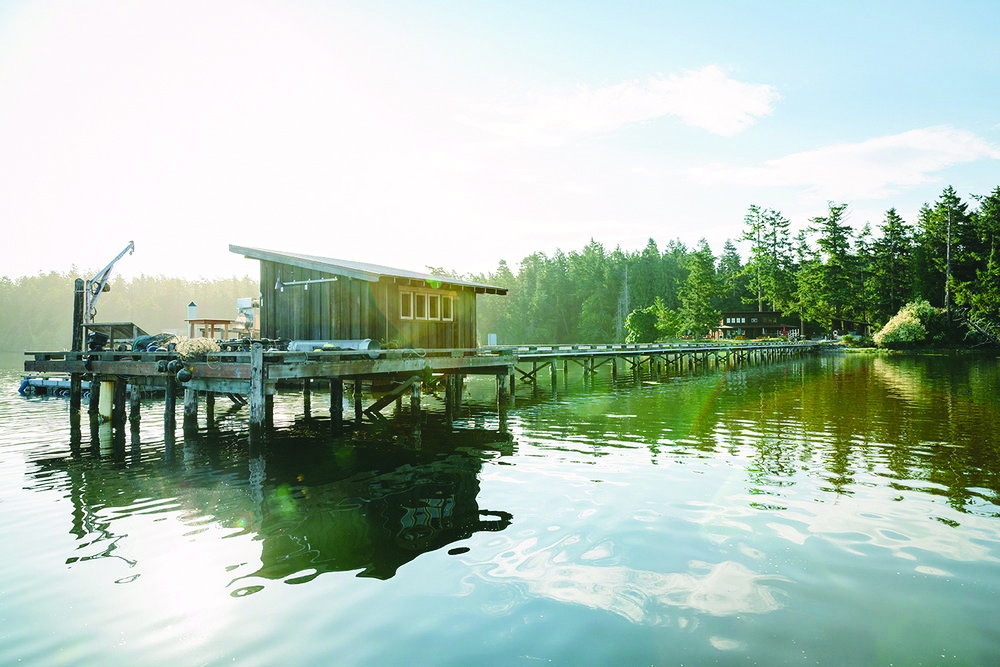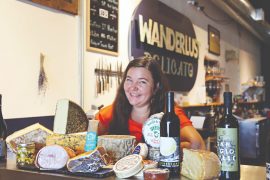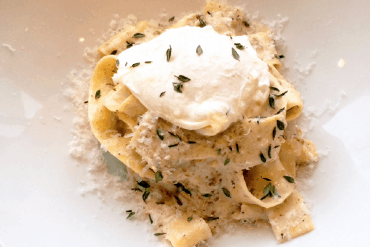Slurp the season’s best from a revived San Juan farm and new Issaquah eatery
written by Corinne Whiting
There’s no denying San Juan Island is touched by something special, and visiting Westcott Bay Shellfish Co. merely elevates the experience. On this family-owned aquaculture farm, a hardworking team sells clams, oysters and mussels raised on their tranquil tidelands. Since 1978, shellfish have been farmed here, and the story of its current owners—Andrea and Erik Anderson—is a winding, charmed tale. (Silence of the Clams Clam Chowder Recipe below.)
The couple visited the farm to purchase oysters for more than thirty years while spending summers on Henry Island. They started dating during freshman year at the University of Washington and often joked they’d love to work at the oyster farm. Fast forward several decades, when they boomeranged back to Henry Island to build a home.




When they learned the farm property was being put up for sale as a home site, they decided to buy the land. “We realized the farm would forever be gone,” Anderson said, “so Erik and I looked at one another and said, ‘How hard can this be?’ In September 2013, we signed the purchase papers for the land (the farm was long gone and hadn’t been planted with shellfish for at least a decade), and started learning everything we could about farming oysters, clams and mussels.”
Over the next four years, they worked tirelessly to restore the property, wanting to honor its community legacy and carry on a philosophy of environmental stewardship. While scrambling to figure things out, they cherished early guidance from Frank Raue and Mark Billington, who worked at the former shellfish farm for nearly thirty years. “The only paid employees in those early days were Frank and Mark,” Anderson said, “but any family or friends who visited would be put to work mending old nets or planting and harvesting shellfish in exchange for oysters, clams, mussels and a day of fun and camaraderie.”
“Clams are the easiest of our shellfish to grow,” Anderson explained, “as we don’t have to do anything during their three-year growth until they are ready to harvest.” The harvesting, however, proves incredibly labor intensive. Workers must get down in the mud to dig by hand, later lugging 50-plus-pound totes back to the dock, where the harvested clams are sorted and cleaned. They are then placed in upper tanks, as water from the bay is continuously pumped in to purge any remaining mud and sand.
Anderson explained that shellfish are flavored by the environment in which they grow. “Westcott Bay has a unique mix of algae and salinity,” she said, “influenced by a fresh-water stream at the top of the farm and a big tidal flush from Haro Strait that creates a flavorful, briny clam. We grow Manila clams, which are plump and bursting with flavor.”
Clam harvesting is entirely dependent on the tide cycle. During summer months, the low tides happen during daylight hours; during winter, low tides occur late at night. Because of this, Anderson said, “Once the weather turns too cold and difficult, we stop going out in headlamps to harvest, which is why we don’t sell clams during winter months.”
Although their bustling al fresco restaurant—The Tide Tables—is open from Memorial Day through Labor Day, retail sales of most shellfish continue throughout the off season (Fridays and Saturdays; pre-orders are encouraged.) Fresh clams return in late spring.
Anderson admits it has been surprising to watch the farm evolve into a coveted destination. They estimate at least 10,000 people visit the farm each summer month. The biggest reward is the incredible team, she said. “We now employ twenty-two people—the majority of whom have grown up and lived on San Juan Island their entire lives. Our Westcott crew consists of a family of extremely hard-working, creative souls who strongly believe in community and stewardship of our natural resources.”
Anderson’s favorite way to enjoy clams? “Our Manila clams are packed with a briny flavor, so they don’t need much help,” she said. “But you can never go wrong with steaming them in a little sautéed garlic and onions in olive oil and white wine, topped off with freshly squeezed lemon and parsley once they open.”
On the mainland, diners enjoy clams at Enzo’s Bistro & Bar in Issaquah, where chef Nick Novello brings his grandmother’s recipes to life. Growing up in an Italian-American household, clams were simply part of the routine. “I had no idea other kids thought these were icky,” Novello said, “until I went to dinner with a friend’s family and ordered the bucket of clams appetizer as my entrée. I was 11.”
When it comes to selection, Novello advised tossing uncooked clams that appear open. When cooking, you can try to assist the opening process with a gentle pry. “If [the shells] are still locked closed,” he said, “stop, toss it. Chances are, it’s full of sand.”
“Clams are fun for the whole family,” Novello said. “I encourage clam digging, as it’s a blast.” His preferred way to enjoy the local delicacy: “I’m a slurp-from-shell guy,” he said, “I get the most clams in my mouth per minute that way.”
Novello sources from Penn Cove Shellfish. Clams are out of the water no longer than twelve hours before landing in his kitchen. “Why would you not use the best,” he asked, “when it’s located right here in Washington?”
RECIPE

Silence of the Clams
Clam Chowder
Woodblock / REDMOND
Heather Hilt
Serves 4
4 stalks celery, chopped small
1 bunch leeks (white only), chopped small
½ yellow onion, chopped small
1 tablespoon garlic, chopped
6 ounces butter
6 ounces flour
1 quart milk
2 cups heavy cream
8 ounces clam juice
10-ounce can chopped clams
1 teaspoon red chili flakes
1 bay leaf
½ lemon, juiced and zested
1½ teaspoons fresh thyme
1 tablespoon salt
2 teaspoons pepper
Optional
2 tablespoons butter
2tablespoons oil
¼ cup white wine
1 pound whole clams
Melt butter in a pot over medium heat. Add all the vegetables and sweat them out. Add chili flakes, thyme and bay leaf and cook for 2 minutes. Add flour and make roux, then cook for 2 minutes.
Add lemon juice, clams and juice, milk and cream. Bring to a boil, stirring occasionally. Season with salt and pepper.
Optional addition: In a separate pot, heat the butter and oil on medium-high heat. Toss in the whole clams and white wine, then cover the pot with a lid.
Give them 4 to 5 minutes to open, then remove the lid and cook off the wine for 1 more minute. Add to your clam chowder base.








I love Westcott Bay Seafood Co. Thank you for focusing on this amazing story and business!